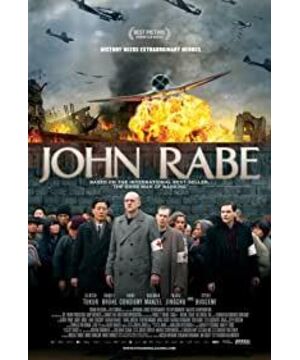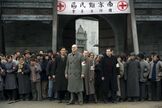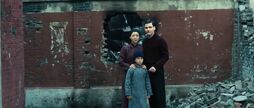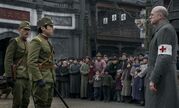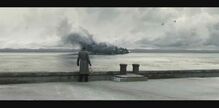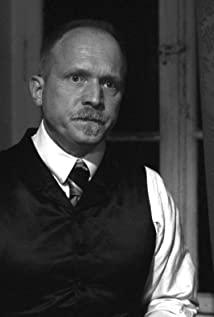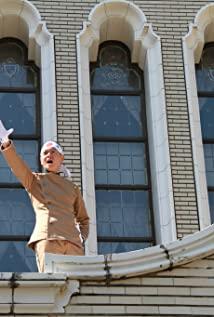The English name of the movie is "John Rabe", which is not as appropriate as "Rabe's Diary", because Gallenberg actually reproduces the group portrait of Western humanitarians in the Nanjing Safety Zone, but it is too superficial, so that it will be dull for a long time. It is so, Rabe is also missing. Using duration as an excuse may not be justified. If every movie has to choose the director's extended version and commentary soundtrack to watch, the film industry is probably dead long ago. It would be better to make a series.
What's interesting is the director's position. In my opinion, the director not only did not amplify Rabe's Nazi identity, but tried to dilute it. In the original book of Rabe’s Diary, Rabe mentioned many times that “the head of state will not leave us behind”. As a German who left the country in 1930, it is really reasonable. At the beginning of the movie, an "extremely loyal party member" was set up to accuse Rabe and others of their random Nazi identities. Later, Dr. Wilson became the vice chairman of the safe zone committee even more abruptly, and he clashed and accepted Rabe. He has repeatedly criticized Rabe’s trust in Hitler. The former appears in the film as a typical American who believes in freedom and justice. It is really correct.
For Nanjing, Gallenberg's treatment also makes the movie seem familiar, almost a typified expression of "one thousand cities". Of course he at least took the notorious "Hundred Kill", but the location was changed to the prison camp. Strangely, Mr. Gallenberg and Mr. Lu both arranged Mr. Han Xianglin together. The former caused Han to be beheaded by the Japanese army for no reason in the movie, and the latter simply changed him into a traitor. The Japanese army's atrocities against civilians throughout the original "Rabe's Diary" (since the Japanese army entered the city, almost every diary has detailed records, from December to the day before Rabe left Nanjing) is not much in the movie, or Bringing a few historical images or narrating them through other people's narratives has also weakened the difficulty and importance of the efforts of the Safe Zone Committee to some extent. There is indeed a description of Wilson facing the gun in the original work, but it is not to protect the wounded, but to prevent the Japanese army from raping the civilians. Rabe also drove away the Japanese army who was committing rape, but it is not visible in the movie. At least, the real Minnie Vettering (Dupre in the movie) has paid much more.
The director also lost the opportunity to add a "human" Japanese Shao Zuo in the film-I believe this is a collection of multiple images of Japanese Shao Zuo in the original work, although none of the latter has risked his death to remind him. The survival crisis of the Bay Safety Zone. Therefore, I still want to quote from Long Yingtai’s "Eavesdropping Storm", "East Knossmark’s film used a lot of on-site shooting in the East German office building, but the curator of the Prison Museum refused his request for filming. . The reason? The curator said, because East Knossmark’s script does not conform to historical facts: throughout the history of East Germany, the secret police who'discovered by conscience' like Weissler, I'm sorry, there is no one." Fortunately, Hatohiko Asakamiya's indifference and cruelty Finally survived.
After reading the original work of "Rabe’s Diary", for the movie, I really want to see Rabe’s greatest enemy, the "East Asian hypocrisy" he has been fighting with, from Tang Shengzhi who promised to withdraw troops from the safe zone on time, to The Japanese ambassadors and Japanese generals who have perfunctorily asked Rabe for the safety of civilians, no exception, regard the lives of civilians as ill-fated. Unfortunately, I never saw it.
"Nanjing! Nanjing! In Rabe’s departure, he left with great guilt, and even knelt down to thank the world. In Rabe’s Diary, the former was boarded in the road farewell. Unfortunately, both of them are legendary interpretations. , Or look at the final description of Rabe and the civilians in the original work:
There are still 3,000 girls and women in the university refugee shelter today. They surrounded the gate and asked me to promise not to leave them alone, that is, they asked me not to leave Nanjing. They all knelt on the ground, crying and screaming. When I was about to leave, they simply grabbed my clothes and put them out. I have to leave my car. After struggling to squeeze a way out of the door, the door behind me was immediately closed. I had to walk home. All this sounds very sad and exaggerated, but if anyone has seen the tragic scene here, he will understand what the protection we give to these poor people means. In fact, all of this is a matter of course. From our point of view, it has nothing to do with a certain heroic quality.
Supplement: Rabe’s driver Zhang Guozhen was beheaded in the movie. Fortunately, the real Zhang Guozhen has never been placed in such a tragic situation.
View more about John Rabe reviews


